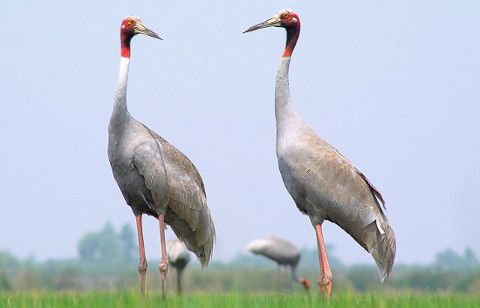In recent years, the red-crowned crane population has decreased in number and rarely appeared in Tram Chim National Park, with only 3 individuals in the most recent time - 2021.
There are three types of red-crowned cranes: Indian cranes, Oriental cranes, and Australian cranes. The Oriental crane, in particular, occurs in Myanmar, Thailand, Cambodia, and Vietnam and has the smallest population among the three species.
As a land blessed by nature and endowed with unique needle grass species, Tram Chim National Park used to be a place visited by red-crowned cranes in the dry season because this grass is their favorite food.
However, the number of red-crowned cranes coming to Tram Chim is seriously decreasing. In 2017, only 3 red-crowned cranes returned, in 2018 there were 9 individuals, and in 2019 there were 11 individuals. In 2020, no red-crowned cranes returned to the garden. After one year, 3 individuals came back to Tram Chim. After that time, it has returned to zero.
Currently, red-crowned cranes are listed as endangered species in the Red Book of Threatened Species of the International Union for Conservation of Nature and Natural Resources (IUCN).
The reason, according to Mr. Nguyen Hoai Bao, lecturer at the University of Natural Sciences - Ho Chi Minh City National University, is the decline in the habitat of red-crowned cranes in the Mekong River basin, including in Laos and Cambodia. In addition, it is also related to the factor of environmental pollution in agricultural cultivation.
He affirmed, “Red-crowned cranes are considered indicators of the wetland environment. When cranes no longer appear, it proves that the environment of that wetland has been degraded and biodiversity has decreased."
Facing that situation, Dong Thap province has implemented a project to preserve and restore the red-crowned crane flock in Tram Chim. Not only is this action meaningful to the crane species, but the project's activities also contribute to restoring habitat for many other species in this wetland.
The project aims to restore and develop the red-crowned crane population at Tram Chim by raising and releasing them back into the wild. Specifically, within 10 years (2023 - 2033), the project strives to raise 150 crane individuals back to the wild with at least 100 surviving individuals – Mr. Nguyen Hoang Minh Hai, Head of Research and International Cooperation Department, said.



